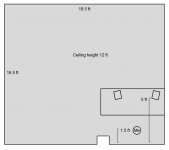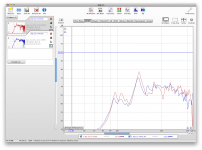Below is the layout of my workshop. My speakers are some tiny Quad L-ite satellites on stands on my desk. I'm aware it's a fairly horrific setup, but this room is primarily a work space, so it's the position I'm stuck.
I'm not expecting any miracles here, but I've got a real problem with the mid-bass. The response curve below is recorded from the inbuilt microphone on my computer (between the speakers) so it makes things look worse than they are, but it does show my problem. Looking at the red line, at 140 hz I've got a 15db peak, then dropping by almost 20db towards 130 hz. The wall behind is plaster on cinder blocks, so I experimented with putting a mattress against the wall (the blue line) which made a noticeable difference, so I'm planning on building some proper sound proofing into the whole corner.
My question is, is treating the wall to absorb some bass the best thing to do? I've read suggestions that some diffusers would possibly be an idea?
Is there anything else I can do with this to try and smooth things out?
Some minor re-arrangement is a possibility, depending on the CAF (colleague acceptance factor).
I'm not expecting any miracles here, but I've got a real problem with the mid-bass. The response curve below is recorded from the inbuilt microphone on my computer (between the speakers) so it makes things look worse than they are, but it does show my problem. Looking at the red line, at 140 hz I've got a 15db peak, then dropping by almost 20db towards 130 hz. The wall behind is plaster on cinder blocks, so I experimented with putting a mattress against the wall (the blue line) which made a noticeable difference, so I'm planning on building some proper sound proofing into the whole corner.
My question is, is treating the wall to absorb some bass the best thing to do? I've read suggestions that some diffusers would possibly be an idea?
Is there anything else I can do with this to try and smooth things out?
Some minor re-arrangement is a possibility, depending on the CAF (colleague acceptance factor).
Attachments
does look a bit funny.
prehaps software eq, or if you are up to it, a notch filter should do the trick better.
(well better is kindof .. has a lot to do with relativity)
prehaps software eq, or if you are up to it, a notch filter should do the trick better.
(well better is kindof .. has a lot to do with relativity)
I would try maybe a diagphram type absorber on the back wall as 5 feet is about a 1/2 wave of 130hz and the refelections could be what is causing your peak at the 130hz region.
This makes sense when you said that an old mattress seems to help.
Also try moving the speakers away from the back wall another two feet and see if the peak lowers in frequency and this should give you a better insight as to what is happening. jer
This makes sense when you said that an old mattress seems to help.
Also try moving the speakers away from the back wall another two feet and see if the peak lowers in frequency and this should give you a better insight as to what is happening. jer
You don't have a 15dB peak in the mid bass - you have about a 5dB peak relative to the midrange at 200-300Hz, at least for one of the speakers, then a much larger measured drop off in the bass below 100Hz.Below is the layout of my workshop. My speakers are some tiny Quad L-ite satellites on stands on my desk. I'm aware it's a fairly horrific setup, but this room is primarily a work space, so it's the position I'm stuck.
I'm not expecting any miracles here, but I've got a real problem with the mid-bass. The response curve below is recorded from the inbuilt microphone on my computer (between the speakers) so it makes things look worse than they are, but it does show my problem. Looking at the red line, at 140 hz I've got a 15db peak, then dropping by almost 20db towards 130 hz.
A couple of observations so you don't spend your time unnecessarily chasing your tail - you say the speakers are tiny (I'm assuming some kind of powered computer speakers ?) in which case I would point out that most such speakers are deliberately tuned with a large upper-bass peak of 6-10dB somewhere between 100-200Hz to "compensate" for a lack of real bass below 100Hz. (The brain is fooled into hearing fundamentals that aren't actually reproduced due to exaggeration of their harmonics in the upper bass region)
In fact with many small ~3-4" drivers used in small boxes it's almost impossible to achieve a tuning that doesn't have a large upper-bass peak whether you want it or not, so it's quite likely this large peak is normal for the speaker design.
Secondly, I doubt whether you'll get an accurate measurement of bass below 100Hz using the built in microphone of a laptop. Even good microphones used for recording vocals often roll off rapidly below 100-150Hz, only a measurement microphone will give you a flat response down to below 50Hz or so.
Without knowing the roll off of the built in microphone in the laptop it's hard to draw conclusions about the apparently sudden roll off below 100Hz.
Without knowing the response of the speakers, you could be expending a lot of effort in trying to apply acoustic treatments to the room for speakers with a fundamentally inbuilt large upper bass peak.The wall behind is plaster on cinder blocks, so I experimented with putting a mattress against the wall (the blue line) which made a noticeable difference, so I'm planning on building some proper sound proofing into the whole corner.
My question is, is treating the wall to absorb some bass the best thing to do? I've read suggestions that some diffusers would possibly be an idea?
Is there anything else I can do with this to try and smooth things out?
Some minor re-arrangement is a possibility, depending on the CAF (colleague acceptance factor).
You'd really want to do a near-field measurement of the bass response up to 200Hz (summed with the port if they're ported) to find out how much of your response is the speakers and how much is the room positioning, but to do so you'd need an external microphone, and one that has reasonably good low frequency response, to make the measurement meaningful.
Other than that you can try to tame down the peak at 150Hz with a parametric EQ, but with a lack of real bass below 100Hz the subjective impression of EQ'ing it flat will be a severe lack of bass - which is the reason why most small speakers put a peak in that region in the first place.
Edit: one more observation is that if you're measuring the response between the speakers and not at the listening position, you're going to get a radically different response than you'll hear at the listening position, particularly when both the right speaker and your head are very close to the nearest walls. Again, an external microphone would allow you to easily measure at the listening position - the response may not be nearly as bad there, so you could be fretting about the response at a location where you will never listen from...
Last edited:
you say the speakers are tiny (I'm assuming some kind of powered computer speakers ?) in which case I would point out that most such speakers are deliberately tuned with a large upper-bass peak of 6-10dB somewhere between 100-200Hz to "compensate" for a lack of real bass below 100Hz.
They're Quad L-ite satellites; small two way bookshelves. A valid point above, but after dropping at 130hz the bass does appear again. I think they're supposed to be -6db at 70hz.
Edit: one more observation is that if you're measuring the response between the speakers and not at the listening position, you're going to get a radically different response than you'll hear at the listening position... so you could be fretting about the response at a location where you will never listen from...
The problem is very much noticeable at the listening position. I only ran the tests to see what would show up.
One thing I noticed is that when standing further to the left of the room, the bass frequencies all smooth out. The only evidence of the problem being my the sound of my desk vibrating at 140hz. Walk back over to the right of the room and the peak hits you.
I think the problem is as geraldfryjr mentioned. I've talked my colleague into letting me rearrange the room, so I will try different positions and see what happens.
Maybe a combination of software EQ and wall insulation would be the best compromise.
doing software eq consumes the verry least effot at first.
it may even reduce the problem to some acceptible lvl.
then, if that does not help at all re-arrangment of the room is what i would advise.
absorving material /bass/reflection trap is not a bad option, but in this example You would need to line things up pretty hard, mooving Your desk a bit seems a less stressing option.
it may even reduce the problem to some acceptible lvl.
then, if that does not help at all re-arrangment of the room is what i would advise.
absorving material /bass/reflection trap is not a bad option, but in this example You would need to line things up pretty hard, mooving Your desk a bit seems a less stressing option.
- Status
- Not open for further replies.

